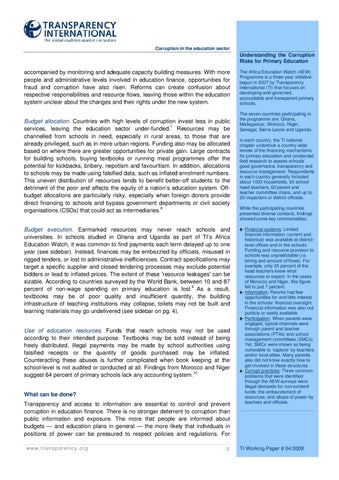Corruption in the education sector
Understanding the Corruption Risks for Primary Education
accompanied by monitoring and adequate capacity building measures. With more people and administrative levels involved in education finance, opportunities for fraud and corruption have also risen. Reforms can create confusion about respective responsibilities and resource flows, leaving those within the education system unclear about the changes and their rights under the new system. Budget allocation. Countries with high levels of corruption invest less in public services, leaving the education sector under-funded.7 Resources may be channelled from schools in need, especially in rural areas, to those that are already privileged, such as in more urban regions. Funding also may be allocated based on where there are greater opportunities for private gain. Large contracts for building schools, buying textbooks or running meal programmes offer the potential for kickbacks, bribery, nepotism and favouritism. In addition, allocations to schools may be made using falsified data, such as inflated enrolment numbers. This uneven distribution of resources tends to benefit better-off students to the detriment of the poor and affects the equity of a nation’s education system. Offbudget allocations are particularly risky, especially when foreign donors provide direct financing to schools and bypass government departments or civil society organisations (CSOs) that could act as intermediaries.8 Budget execution. Earmarked resources may never reach schools and universities. In schools studied in Ghana and Uganda as part of TI’s Africa Education Watch, it was common to find payments each term delayed up to one year (see sidebar). Instead, finances may be embezzled by officials, misused in rigged tenders, or lost to administrative inefficiencies. Contract specifications may target a specific supplier and closed tendering processes may exclude potential bidders or lead to inflated prices. The extent of these 'resource leakages' can be sizable. According to countries surveyed by the World Bank, between 10 and 87 percent of non-wage spending on primary education is lost.9 As a result, textbooks may be of poor quality and insufficient quantity, the building infrastructure of teaching institutions may collapse, toilets may not be built and learning materials may go undelivered (see sidebar on pg. 4). Use of education resources. Funds that reach schools may not be used according to their intended purpose. Textbooks may be sold instead of being freely distributed, illegal payments may be made by school authorities using falsified receipts or the quantity of goods purchased may be inflated. Counteracting these abuses is further complicated when book keeping at the school-level is not audited or conducted at all. Findings from Morocco and Niger suggest 64 percent of primary schools lack any accounting system.10 What can be done? Transparency and access to information are essential to control and prevent corruption in education finance. There is no stronger deterrent to corruption than public information and exposure. The more that people are informed about budgets — and education plans in general — the more likely that individuals in positions of power can be pressured to respect policies and regulations. For w w w. t r a n s p a r e n c y . o r g
3
The Africa Education Watch (AEW) Programme is a three-year initiative begun in 2007 by Transparency International (TI) that focuses on developing well-governed, accountable and transparent primary schools. The seven countries participating in the programme are: Ghana, Madagascar, Morocco, Niger, Senegal, Sierra Leone and Uganda. In each country, the TI national chapter undertook a country-wide review of the financing mechanisms for primary education and conducted field research to assess schools’ good governance, transparency and resource management. Respondents in each country generally included about 1000 households, 60 school head teachers, 60 parent and teacher committee chairs, and up to 20 inspectors or district officials. While the participating countries presented diverse contexts, findings showed some key commonalities. Financial systems: Limited financial information (current and historical) was available at districtlevel offices and in the schools. Funding and resource provision to schools was unpredictable (i.e. timing and amount of flows). For example, only 35 percent of the head teachers knew what resources to expect. In the cases of Morocco and Niger, this figure fell to just 7 percent. Information: Parents had few opportunities for and little interest in the schools’ financial oversight. Financial information was also not publicly or easily available. Participation: When parents were engaged, typical channels were through parent and teacher associations (PTAs) and school management committees (SMCs). Yet, SMCs were shown as being vulnerable to ‘capture’ by teachers and/or local elites. Many parents also did not know exactly how to get involved in these structures. Corrupt practices: Three common problems that were identified through the AEW surveys were: illegal demands for non-existent funds; the embezzlement of resources; and abuse of power by teachers and officials.
TI Working Paper # 04/2009
